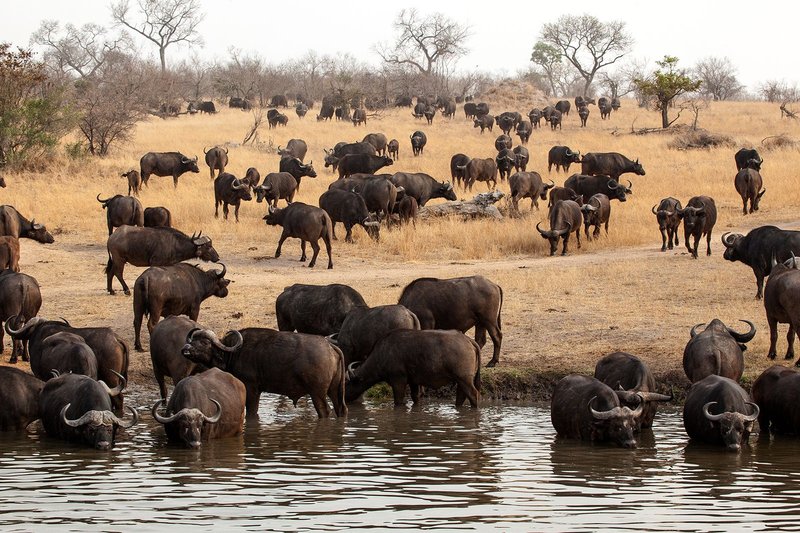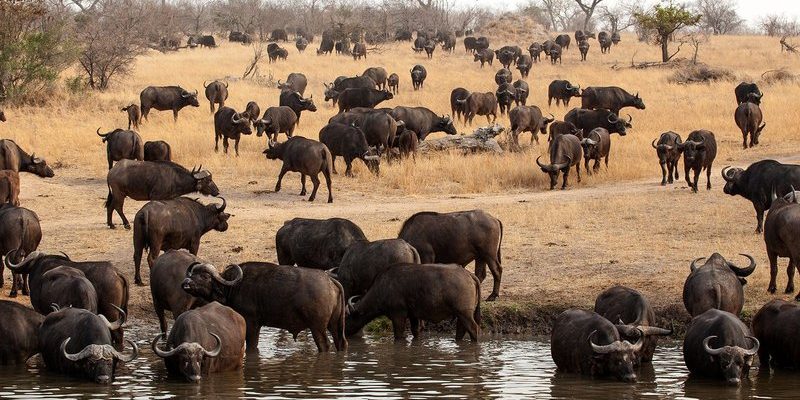
African Buffalo Species Overview
Before we dig into their habitat, it’s helpful to know a bit about the African buffalo species. There are several subspecies, but the most notable ones are the Cape buffalo and the forest buffalo.
– Cape Buffalo: This is the most common type, usually found in savannas and grasslands. They are known for their robust build and impressive horns, which can grow large and curved.
– Forest Buffalo: As the name suggests, these guys prefer thick forests and woodlands. They are smaller and have a reddish-brown coat, which helps them blend into their leafy surroundings.
Both subspecies have unique adaptations that allow them to thrive in their respective environments. If you’ve ever seen a cape buffalo in the wild, you might have noticed how they travel in groups, known as herds, which can help protect them from predators.
Natural Habitat of African Buffalos
African buffalos are incredibly adaptable and can thrive in a range of habitats. Their main habitats include:
- Savannas: Open grasslands dotted with trees where they can graze on grasses.
- Swamps and Marshes: Wetland areas that provide food and water, especially during dry seasons.
- Wooded Areas: Locations with plenty of shade where they can hide from the sun.
These diverse environments allow buffalos to find food and water easily while staying protected from the harsh sun or lurking predators. In fact, these animals are known to be quite social, often found in large groups that can number in the hundreds, which gives them safety in numbers.
Geographic Distribution Across Africa
African buffalos are primarily found in sub-Saharan Africa. Their range stretches from West Africa, where they roam through the lush wetlands, to the Southern regions where they thrive in the grasslands of countries like South Africa and Namibia.
In East Africa, their distribution often overlaps with popular national parks like the Serengeti in Tanzania and the Maasai Mara in Kenya, where they are a staple sight for tourists. Here’s a simple breakdown of where to find them:
– West Africa: Countries like Ghana and Nigeria, primarily in savanna regions.
– East Africa: Tanzania, Kenya, and Uganda, thriving in national parks and reserves.
– Southern Africa: Botswana, South Africa, and Namibia, where they inhabit open grasslands and wooded areas.
Their ability to inhabit various ecosystems is remarkable and helps maintain the ecological balance in those areas.
Why Habitat Matters for African Buffalos
You might be wondering, “Why does their habitat matter?” Well, the habitat impacts everything from their diet to their reproductive success. Here are a few key reasons:
1. Foraging Opportunities: African buffalos are predominantly grazers, relying on the availability of grasses and other vegetation. If their habitat is healthy and lush, they can get the nutrition they need to thrive.
2. Social Structure: The availability of safe habitats affects herd dynamics. In open areas, buffalos can easily spot predators, allowing them to stay together and protect their young.
3. Breeding Habitats: Some habitats offer better conditions for raising young. For example, areas with dense cover can provide safety for calves, while open spaces are beneficial for the herd’s movement and grazing.
Without a suitable habitat, African buffalos struggle to find food, reproduce, and escape threats. Unfortunately, habitat loss due to human activity, like farming and urban development, poses a significant threat to their populations.
Challenges to Their Habitat
Despite their adaptability, African buffalos face several challenges that threaten their habitats:
– Human Encroachment: As people expand their farmland and settlements, buffalos lose access to vital grazing areas. This loss not only directly impacts their food sources but also leads to increased conflicts with humans.
– Climate Change: Changing weather patterns can affect their habitats. For instance, prolonged droughts can diminish water sources and food availability, leading to stress on buffalo populations.
– Poaching: Illegal hunting continues to endanger buffalos. Although they are not the most targeted species, poaching for their horns or meat still impacts local populations.
Conservation efforts are crucial in addressing these issues to preserve the habitats where buffalos thrive. Protecting their environments benefits not just buffalos but also the entire ecosystem.
Conservation Efforts and Their Importance
Many organizations focus on protecting African buffalos and their habitats. These efforts include:
– Protected Areas: Establishing national parks and reserves helps safeguard habitats. Places like the Serengeti or Kruger National Park are prime examples where buffalos can roam freely and safely.
– Community Involvement: Engaging local communities in conservation initiatives is vital. When people see the value of protecting buffalos and their environment, they are more likely to help conserve these habitats.
– Research and Monitoring: Scientists keep track of buffalo populations and habitat health, helping to inform conservation strategies. Understanding their behavior and needs allows for effective management.
Ultimately, conserving African buffalos and their habitats is not just about saving a species; it’s about preserving a piece of Africa’s natural heritage.
So, where do African buffalos live? They inhabit a variety of habitats across sub-Saharan Africa, from savannas to wetlands. Their presence is crucial for maintaining the balance of their ecosystems, and their adaptability is quite impressive. However, their survival is now at risk due to human activities and climate change.
By supporting conservation efforts and understanding the importance of their habitats, we can help protect these remarkable animals for future generations. African buffalos are more than just a beautiful sight on a safari—they’re integral to the rich tapestry of life in Africa. Every step we take to protect their home also protects the diversity and beauty of the natural world around us.

